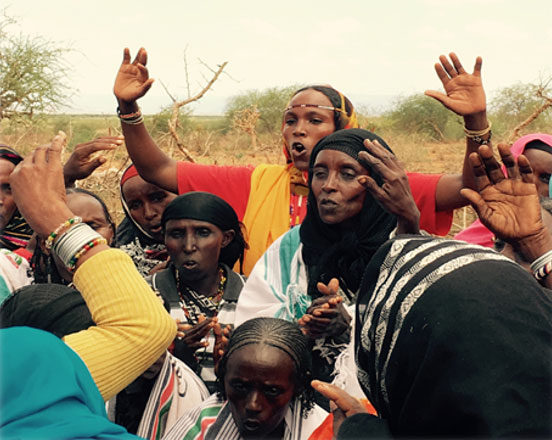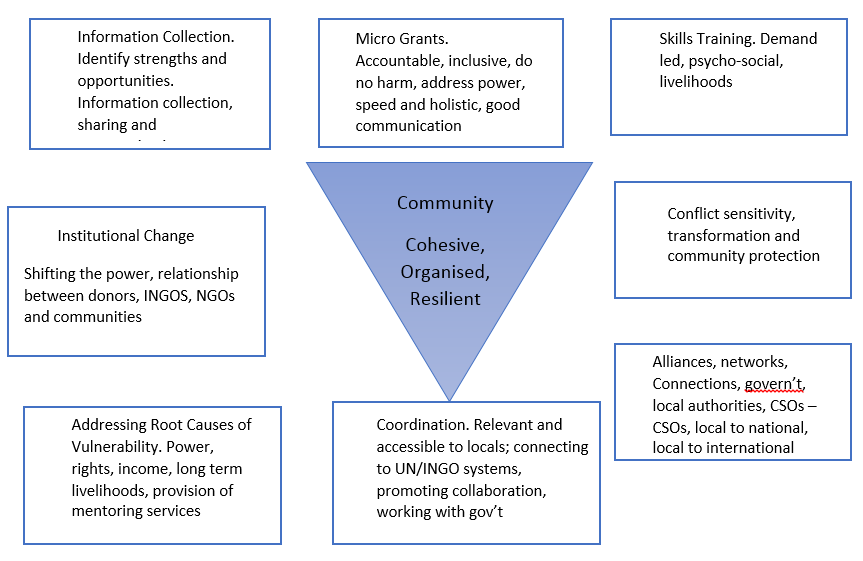By Becky Murphy @Christian Aid and @Kings College London

Image; © Becky Murphy, Christian Aid
“I am because we are” (John Mbiti)
It’s mid-October in rural north Kenya. The LPRR project has travelled to Marsabit, Kenya, near the Ethiopia boarder. Here, the LPRR project implements a six-day co-developed workshop to put the LPRR approach into practice alongside both Christian Aid and CAFOD’s local partners (PACIDA, MIONET, CIFA and Caritas Maralal, Marsabit and Isiolo). After two years of research and work, the team were very excited to start putting findings into practice in Kenya and compare how it might work with the pilot conducted in Myanmar in August.
The approach is based on the six recommendations captured by the LPRR research which explored 327 crises survivor and first responders’ perception of how to strengthen humanitarian response to build (and not undermine) long term community resilience. The recommendations included focusing on areas of crises survivor led response, psycho social support, working with the government, tackling root causes, re-establishing livelihoods and strengthening community cohesion through good communication and collaboration.
Here, the team coordinated with PACIDA to align the approach with the LPRR’s existing conflict strand and the work done on macro and micro conflict analysis, action plans and peace committees. Then the whole team of local patterns, community representatives and local government worked together to design a plan of action for empowering the community to co-run humanitarian response.
Christian Aid and Kings College London then collaborated with Church of Sweden and Local to Global Protection to put this into practice and align:
- A survivor led, micro-grant response centred around community cohesion, wellbeing and psycho-social support,
- How to advocate for root causes to be addresses,
- Livelihoods to be re-established immediately after a crises and,
- Collaboration, communication and government relationships to be strengthened. (Quite ambitious to do during any emergency response).
However, on 26 October, the country will, for the first time hold a re-election. Here, the judicial system critiqued the polling form the August election and demanded a re-vote to ensure a fair result. This will be the first time in Kenya that an election result has been questioned, rejected and over-turned, and, in areas of political and tribal tension such as Marsabit, this dramatically increases the risk of tension, conflict and violence. Furthermore, over the days leading up to the 26th October; the elections have been cancelled and re-launched again causing feelings of political instability, confusion and anger amongst voters.
In addition to this, Marsabit are still battling with the impact of the failed long rains and resulting drought last March and there are growing fears that the rains expected this month will also fail. This therefore, puts the county in high alert for crises response and makes the context both challenging and very appropriate for this approach to be piloted in. Over the next three months LPRR will follow the situation and mentor the teams to see if this approach can work in practice.
1. What is the approach?
The approach has eight components (illustrated below in figure 1) which are worked though in a six-day co-developed workshop. As you can see it is centred around community wellbeing and resilience. Here, participants work together to recognise the existing capacities and networks in a community and aim to build on and strengthen community cohesion. We then work our way around the components. For more detail, you can check out the Myanmar blog.
Figure 1: The LPRR Steps

2. What have we learnt?
It is always interesting to see how and if approaches implement in one country and context can work in another. The partner organisations were very enthusiastic about the approach whilst also being excellently critical. We broke down the approach together, applying it to the Marsabit conflict and drought context. Here, we learnt of examples where this approach could work and what the strengths and challenges could be.
Strengths
The main strengths aligned nicely with the LPRR research. Participants strongly agreed with the need for psycho social support in humanitarian response and the need to align with the county government and country development plans, and National Disaster Management Authority (NDMA). Here, the participants strongly and enthusiastically supported the idea of centring humanitarian response around community wellbeing; aligning with social fabric and supporting community togetherness. Participants were excited about the need to move beyond just material humanitarian response; food, water, shelter and instead centre the approach around all aspects of community wellbeing. “Community members are not like goats, they need more than food and water to survive” (Participant, 2017).
Challenges
However, participants were a little wary of the level of community capacity to run an emergency response. Whilst the idea of enabling the community to co-run the response is felt by participants to enable community members to be empowered and long-term resilience strengthened; participants also explained that there is a need for NGOs to mentor, support and be there to help community pop up groups. Additionally, participants felt that they could also tie this into the existing government youth funds and women funds; thus, enabling initiatives to continue even without funding from (I)NGO’s.
The main concerns from participants included whether donors and INGO’s back in London had truly given their approval for this approach to be implemented. Participants questioned the impact that the approach could have on the aid system, if successful. Equally questions around how they would ensure the right people are involved in the micro grants, how to avoid grant misuse, how to ensure no harm is done and what to do is the community don’t know how to respond or what to do. Here, a set of tools, checklists and guidance were developed with participants to ensure inclusion, do no harm, accountability and good communication. Keep following the LPRR project to find out more.
Recommendations for working with the government
Lastly, the participants reflected on how civil society could work with the government to improve governance and strengthen the relationship between local government and communities. Here, the participants (made up of both civil society organisations and government representatives) mapped out the following recommendations:
- Share responsibility
- Include the government in technical skills building
- Practice good information sharing between civil society, the community and the government
- Join forces on lobbying the national government
- Practice join needs assessments
- Share resources
- Set up join coordination platforms
- Build trust
How?
- Regular meetings
- Planning sessions together
- Share skilled personnel
Next steps
Next, the LPRR project will with work with L2GP to mentor the implementing partners and with DCA to monitor both pilots in Myanmar and Kenya. We will be sharing learning, success stories, challenges and evidence from this localisation in practice approach over the coming months. For more information contact Becky Murphy at rmurphy@christian-aid.org or Simone Di Vicenz at Sdivicenz@christian-aid.org. For more information on Christian Aid’s response to the East Africa drought, take a look at their website: https://www.christianaid.org.uk/emergencies